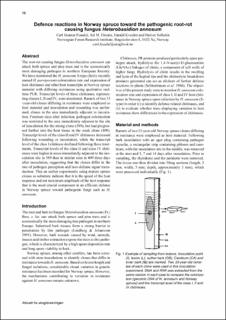| dc.contributor.author | Fossdal, Carl Gunnar | |
| dc.contributor.author | Hietala, Ari Mikko | |
| dc.contributor.author | Kvaalen, Harald | |
| dc.contributor.author | Solheim, Halvor | |
| dc.date.accessioned | 2020-08-25T12:31:30Z | |
| dc.date.available | 2020-08-25T12:31:30Z | |
| dc.date.created | 2020-08-24T13:56:42Z | |
| dc.date.issued | 2006 | |
| dc.identifier.isbn | 82-8083-087-1 | |
| dc.identifier.uri | https://hdl.handle.net/11250/2673962 | |
| dc.description.abstract | The root-rot causing fungus Heterobasidion annosum can attack both spruce and pine trees and is the economically most damaging pathogen in northern European forestry. We have monitored the H. annosum S-type (fairly recently named H. parviporum) colonization rate and expression of host chitinases and other host transcripts in Norway spruce material with differing resistances using quatitative realtime PCR. Transcript levels of three chitinases, representing classes I, II and IV, were monitored. Ramets of two 33-year-old clones differing in resistance were employed as host material and inoculation and wounding was performed. clones in the area immediately adjacent to inoculation. Fourteen days after infection, pathogen colonization was restricted to the area immediately adjacent to the site of inoculation for the strong clone (589), but had progressed further into the host tissue in the weak clone (409). Transcript levels of the class II and IV chitinases increased following wounding or inoculation, while the transcript level of the class I chitinase declined following these treatments. Transcript levels of the class II and class IV chitinases were higher in areas immediately adjacent to the inoculation site in 589 than in similar sites in 409 three days after inoculation, suggesting that the clones differ in the rate of pathogen perception and host defense signal transduction. This an earlier experiments using mature spruce clones as substrate indicate that it is the speed of the host response and not maximum amplitude of the host response that is the most crucial component in an efficient defense in Norway spruce toward pathogenic fungi such as H. annosum. | |
| dc.language.iso | eng | |
| dc.relation.ispartof | Forest pathology research in the Nordic and Baltic countries 2005. Proceedings from the SNS meeting in Forest Pathology at Skogbrukets Kursinstitutt, Biri, Norway, 28-31 August 2005 | |
| dc.title | Defence reactions in Norway spruce toward the pathogenic root-rot causing fungus Heterobasidion annosum | |
| dc.type | Others | |
| dc.description.version | publishedVersion | |
| dc.source.pagenumber | 16-17 | |
| dc.identifier.cristin | 1824823 | |
| cristin.ispublished | true | |
| cristin.fulltext | original | |
